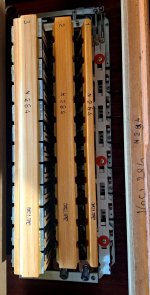There are top models indeed, like the Hohner Gola and Scandalli Super VI. But there is a world of difference between a Gola from the 1960's and a Gola from around 2000. (And I have worked on both.) And there is a world of difference between a Scandalli Super VI from the 1960's and a Super VI from around 2000. A friend of mine has a Super VI from the 1960's and has experienced that a repairer tried (and failed) to convince her that the reeds needed to be replaced (which just means the repairer wanted to steal the old high quality reeds that are no longer being made). And I have just finished work on a Super VI XL from about 20 years ago and it is clearly no longer the absolute top quality accordion the Super VI was in the 1960's. It's not bad, but for instance the leather valves (treble side) inside the reed blocks do not have booster springs, which is a disaster for the ones in cassotto. Nobody who makes a top accordion would leave out the booster springs inside the reed blocks. It's a cost-cutting measure unworthy of an accordion that is labeled Scandalli Super VI.
It is very unfortunate that way too many accordion dealers with supposedly good reputations hire nothing less than butchers to do repairs. There are no official degrees or licenses to become an accordion repairer: everyone can start an accordion repair business and start butchering accordions. And as most accordion players by far are amateurs who do not look inside their accordion and who are happy with repairs and tuning they will give good ratings to repairers and spread the word how happy they are with the work, even though when experts look inside the accordions they find out that for instance the reeds have been butchered using a Dremel. I have friends who do accordion repair as well (and for much longer than I do it) and they can confirm that even high end accordions come in that show clear signs of having been butchered, by the repairers of supposedly reputable dealers.
Sorry, but I do know that a Hohner Gola from 1960 was a top accordion when it was new. But whether a specific Hohner Gola from 1960 is still a top accordion really requires close inspection inside and out. Too many of them have indeed been butchered. On this forum JerryPH traveled from Canada to Germany to buy a 1960's Gola and take it back to Canada. You cannot trust that any old Gola is still in tip top shape and worth the money and have it shipped to you. You have to go see it and try it. That's how it is.
And there are top models of today as well, with some properties that cannot be matched by the top accordions from yesteryear. When you try a Pigini Nova for instance it you will find out that it is lighter to the touch than any accordion from 60 to 70 years ago. The same holds for the top instruments of other brands as well.
What I own and play? I play mostly the Pigini C39 bass accordion as I like the bass accordion a lot and play it in 5 different ensembles. It may not be the best bass accordion but it is currently the only 3 voice bass accordion with registers that's still in production. (Before that I had a Bugari bass accordion, and quality-wise the Bugari was better, but it was only 2 voice without registers.) For regular accordions I play mostly my AKKO bayan (model "super de luxe") and occasionally my Hohner (morino) Artiste X S, a Bugari 508/ARS/C and a Bugari 540/ARS/C. These accordions are all used in the recordings on my YouTube channel. All of these are really good accordions, but none of them are absolute top accordions. I am not a good-enough player to feel worthy of playing the absolute top (even though I could afford a top instrument, or even a few if I wanted). I feel privileged to sometimes get a chance to handle a top accordion and be allowed to do repairs and tuning on it. I may not be the best and certainly not the most experienced accordion repairer, but I have yet to meet any other accordion repairer who tunes better (more accurately) than I do.
 ) I would think that is a very good choice!
) I would think that is a very good choice!



